Update 2025 April 28: (1) It took a lot of work but we finished preparing another great batch of images, thanks for your patience! (2) Welcome University of Washington undergraduate student Naomi to the project science team! (3) New to the project? Check out this incredible and accurate AI-generated podcast about our super-paper! (4) Stay tuned for an exciting new Active Asteroids subproject that will include data from the Canada-France-Hawaii Telescope (CFHT)! This will be an alternate workflow we hope to have live in May 2025!
Results
Project results are summarized here, starting with the newest items.
The Active Asteroids Citizen Science Program: Overview and First Results (2024 March)

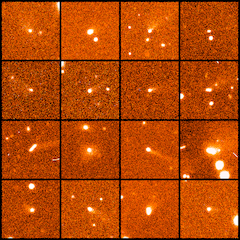
Images credit: (left) Colin Chandler (University of Washington), (right) Henry Hsieh (Planetary Science Institute)
This represents the first all-encompassing, peer-reviewed journal article about our Active Asteroids program. We describe 20 discoveries stemming from the project, including 16 previously unknown active objects. The open access article is here, and a great NASA article is here, and an excellent Zooniverse article can be found here.
Citation: Chandler, C.O., Trujillo, C.A., Oldroyd, W.J., Kueny, J.K., Burris, W.A., Hsieh, H.H., DeSpain, J.A., Sedaghat, N., Sheppard, S.S., Farrell, K.A., Trilling, D.E., Gustafsson, A., Magbanua, M.J.M., Mazzucato, M.T., Bosch, M.K.D., Shaw-Diaz, T., Gonano, V., Lamperti, A., da Silva Campos, J.A., Goodwin, B.L., Terentev, I.A., Dukes, C.J.A., Deen, S., 2024. The Active Asteroids Citizen Science Program: Overview and First Results. The Astronomical Journal 167, 156. https://doi.org/10.3847/1538-3881/ad1de2
2016 UU121: An Active Asteroid Discovery via AI-enhanced Citizen Science (2024 February)
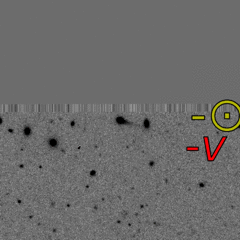
In a first (along with 2008 GB140, see below) for active asteroid and Main-belt comet (MBC) discovery, 2016 UU121 was identified as active by an AI assistant prototype designed to help the Active Asteroids project by filtering out images that are highly unlikely to show any activity. This effort was led jointly by Colin Chandler and Nima Sedaghat. The open access article can be found here.
Citation: Sedaghat, N., Chandler, C.O., Oldroyd, W.J., Trujillo, C.A., Burris, W.A., Hsieh, H.H., Kueny, J.K., Farrell, K.A., DeSpain, J.A., Magbanua, M.J.M., Sheppard, S.S., Mazzucato, M.T., Bosch, M.K.D., Shaw-Diaz, T., Gonano, V., Lamperti, A., da Silva Campos, J.A., Goodwin, B.L., Terentev, I.A., Dukes, C.J.A., 2024. 2016 UU121: An Active Asteroid Discovery via AI-enhanced Citizen Science. Research Notes of the American Astronomical Society 8, 51. https://doi.org/10.3847/2515-5172/ad2b66
AI-enhanced Citizen Science Discovery of an Active Asteroid:(410590) 2008 GB140 (2024 February)
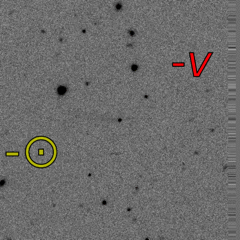
In this first for our field (jointly with the 2016 UU121 discovery, see above), a prototype AI assistant helped identify 2008 GB140 as an active asteroid. The open access publication can be found here.
Citation: Chandler, C.O., Sedaghat, N., Oldroyd, W.J., Trujillo, C.A., Burris, W.A., Hsieh, H.H., Kueny, J.K., Farrell, K.A., DeSpain, J.A., Magbanua, M.J.M., Sheppard, S.S., Mazzucato, M.T., Bosch, M.K.D., Shaw-Diaz, T., Gonano, V., Lamperti, A., da Silva Campos, J.A., Goodwin, B.L., Terentev, I.A., Dukes, C.J.A., 2024. AI-enhanced Citizen Science Discovery of an Active Asteroid: (410590) 2008 GB140. Research Notes of the American Astronomical Society 8, 50. https://doi.org/10.3847/2515-5172/ad2b67
New Active Quasi-Hilda Asteroid 2004 CV50: A Citizen Science Discovery (2023 November )
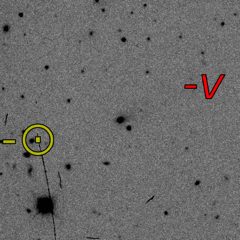
This object, 2004 CV50, represents another discovery of a quasi-Hilda comet (QHC) prompted by project volunteers. These objects are quite rare, with fewer than 20 known. The open access article can be found here.
Citation: Chandler, C.O., Oldroyd, W.J., Trujillo, C.A., Burris, W.A., Hsieh, H.H., Kueny, J.K., Farrell, K.A., DeSpain, J.A., Sedaghat, N., Magbanua, M.J.M., Sheppard, S.S., Mazzucato, M.T., Bosch, M.K.D., Shaw-Diaz, T., Gonano, V., Lamperti, A., Dukes, C.J.A., Terentev, I.A., Campos, J.A. da S., Goodwin, B.L., 2023. New Active Quasi-Hilda Asteroid 2004 CV50: A Citizen Science Discovery. Res. Notes AAS 7, 237. https://doi.org/10.3847/2515-5172/ad09c1
Activity Discovered on Mars-Crossing Jupiter Family Comet 2018 OR by Citizen Scientists (2024 January 11)
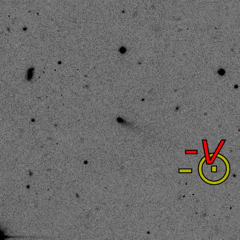
Project Scientist Kennedy Farrell (Northern Arizona University) led the open access publication, available here, about an unusual solar system object, 2018 OR, that is a Jupiter Family Comet as well as an object that crosses Mars' orbit.
Citation: Farrell, K.A., Chandler, C.O., Oldroyd, W.J., Trujillo, C.A., Burris, W.A., Hsieh, H.H., Kueny, J.K., DeSpain, J.A., Mendoza Magbanua, M.J., Sedaghat, N., Sheppard, S.S., Mazzucato, M.T., Bosch, M.K.D., Shaw-Diaz, T., Gonano, V., Lamperti, A., da Silva Campos, J.A., Goodwin, B.L., Terentev, I.A., Dukes, C.J.A., 2024. Activity Discovered on Mars-Crossing Jupiter Family Comet 2018 OR by Citizen Scientists. Research Notes of the American Astronomical Society 8, 18. https://doi.org/10.3847/2515-5172/ad1c66
Mars-Crossing Minor Planet 2018 VL10: a Jupiter-family Comet Discovery via Citizen Science (2023 December 20)
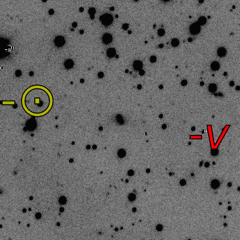
This interesting object, flagged as active by project volunteers, comes to within 0.5 au of Earth (where one au is the average distance from Earth to the Sun). The open access article can be found here.
Citation: Chandler, C.O., Oldroyd, W.J., Trujillo, C.A., Hsieh, H.H., Burris, W.A., Kueny, J.K., DeSpain, J.A., Sedaghat, N., Farrell, K.A., Magbanua, M.J.M., Sheppard, S.S., Mazzucato, M.T., Bosch, M.K.D., Shaw-Diaz, T., Gonano, V., Lamperti, A., da Silva Campos, J.A., Goodwin, B.L., Terentev, I.A., Dukes, C.J.A., 2023. Mars-Crossing Minor Planet 2018 VL10: a Jupiter-family Comet Discovery via Citizen Science. Research Notes of the American Astronomical Society 7, 279. https://doi.org/10.3847/2515-5172/ad1682
Cometary Activity Discovered on Vacationing Centaur 2019 OE31 (2023 December 15)
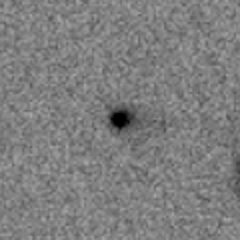
This very unusual object, 2019 OE31, was identified by volunteers as showing activity. Independently, astronomer Sam Deen emailed us about this very same object, with strong evidence it has been active. The object appears to be a quasi-Hilda comet, but it had an incredibly close encounter with Jupiter recently, and it appears to have previously been a Centaur, found between the orbits of Jupiter and Neptune. The open access article can be found here.
Citation: Oldroyd, W.J., Chandler, C.O., Trujillo, C.A., Deen, S., Hsieh, H.H., Farrell, K.A., DeSpain, J.A., Kueny, J.K., Burris, W.A., Sheppard, S.S., Sedaghat, N., Magbanua, M.J.M., Mazzucato, M.T., Bosch, M.K.D., Shaw-Diaz, T., Gonano, V., Lamperti, A., da Silva Campos, J.A., Goodwin, B.L., Terentev, I.A., Dukes, C.J.A., 2023. Cometary Activity Discovered on Vacationing Centaur 2019 OE31. Research Notes of the American Astronomical Society 7, 270. https://doi.org/10.3847/2515-5172/ad14f5
New Active Jupiter Family Comet 2008 QZ44: a Discovery with Citizen Science (2023 December 14)
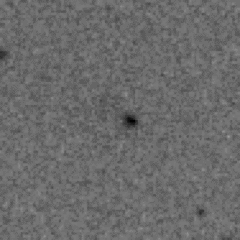
After project volunteers flagged an image of 2008 QZ44 as showing activity, our science team found images of activity from a second orbit. This marks the second recurrently active Jupiter-family comet (JFC) the project identified. The open access article can be found here.
Citation: Chandler, C.O., Oldroyd, W.J., Trujillo, C.A., Hsieh, H.H., Sedaghat, N., Kueny, J.K., Burris, W.A., DeSpain, J.A., Farrell, K.A., Magbanua, M.J.M., Sheppard, S.S., Mazzucato, M.T., Bosch, M.K.D., Shaw-Diaz, T., Gonano, V., Lamperti, A., da Silva Campos, J.A., Goodwin, B.L., Terentev, I.A., Dukes, C.J.A., 2023. New Active Jupiter Family Comet 2008 QZ44: a Discovery with Citizen Science. Research Notes of the American Astronomical Society 7, 271. https://doi.org/10.3847/2515-5172/ad14f6
Citizen Science Discovery of a Recurrently Active Jupiter-Family Comet:(551023) 2012 UQ192 (2023 December 5)
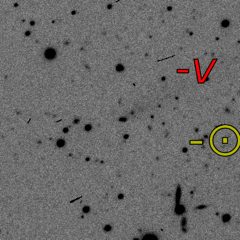
Project scientist and Northern Arizona University student Jarod DeSpain led this work, available free (open access) here, about a Jupiter Family Comet that volunteers identified as active. Our team uncovered images of 2012 UQ192 active during another orbit, which, at the time, was a first for our project.
Citation: DeSpain, J.A., Chandler, C.O., Oldroyd, W.J., Hsieh, H.H., Trujillo, C.A., Burris, W.A., Kueny, J.K., Farrell, K.A., Mendoza Magbanua, M.J., Sedaghat, N., Sheppard, S.S., Mazzucato, M.T., Bosch, M.K.D., Shaw-Diaz, T., Gonano, V., Lamperti, A., da Silva Campos, J.A., Goodwin, B.L., Terentev, I.A., Dukes, C.J.A., 2023. Citizen Science Discovery of a Recurrently Active Jupiter-Family Comet: (551023) 2012 UQ192. Research Notes of the American Astronomical Society 7, 257. https://doi.org/10.3847/2515-5172/ad0ed6
A Jupiter-family Comet Discovery via Citizen Science: 2005 XR132 (2023 August 9)
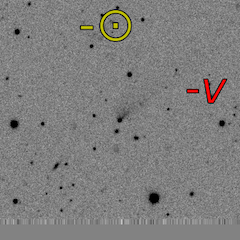
Here volunteers identified an image showing a dramatic, fan-shaped tail emanating from 2005 XR132. The object is dynamically classified as a Jupiter-family comet (JFC) and, as it turns out, it had previously been reported as active by YC Cheng. Our open access article (and linked errata) can be found here. The YC Cheng article can be found (open access) here.
Citation: Chandler, C.O., Oldroyd, W.J., Trujillo, C.A., Hsieh, H.H., Burris, W.A., Kueny, J.K., DeSpain, J.A., Farrell, K.A., Magbanua, M.J.M., Sheppard, S.S., Mazzucato, M.T., Bosch, M.K.D., Shaw-Diaz, T., Gonano, V., 2023. A Jupiter-family Comet Discovery via Citizen Science: 2005 XR132. Research Notes of the American Astronomical Society 7, 146. https://doi.org/10.3847/2515-5172/ace5ad
Cometary Activity on Quasi-Hilda Object 2018 CZ16 (2023 May 26)
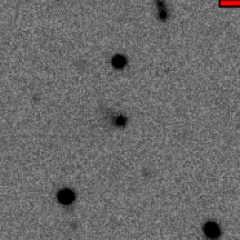
Volunteers identified images of 2018 CZ16 as showing activity, and our follow-up investigation revealed two additional images of the object with activity in the form of a short, fan-shaped tail. Our orbital modeling revealed this object is a member of the quasi-Hildas, of which just 15 or so are known to be active! The open access publication is available here. Note that here we have a number of Citizen Science co-authors!
Citation: Trujillo, C.A., Chandler, C.O., Oldroyd, W.J., Burris, W.A., Hsieh, H.H., Kueny, J.K., Mazzucato, M.T., Bosch, M.K.D., Shaw-Diaz, T., Gonano, V., 2023. Cometary Activity on Quasi-Hilda Object 2018 CZ16. Research Notes of the American Astronomical Society 7, 106. https://doi.org/10.3847/2515-5172/acd7f0
New Active Asteroid 2007 FZ18 (2023 May 24)
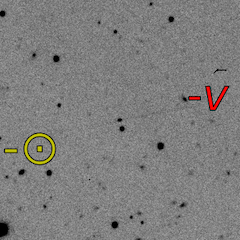
Volunteers flagged one image of this object as showing activity, and it was the only one we found despite an extensive archival image search. Nonetheless, the image is fantastic, with two distinct tails, one each facing away from the Sun (caused by solar wind) and one behind the object. The open access Note can be found here.
Citation: Chandler, C.O., Oldroyd, W.J., Hsieh, H.H., Trujillo, C.A., Burris, W.A., Kueny, J.K., DeSpain, J.A., Farrell, K.A., Mazzucato, M.T., Bosch, M.K.D., Shaw-Diaz, T., Gonano, V., 2023. New Active Asteroid (588045) 2007 FZ18. Research Notes of the American Astronomical Society 7, 102. https://doi.org/10.3847/2515-5172/acd768
(New Recurrently Active Main-belt Comet 2010 LH15 (2023 March 22)
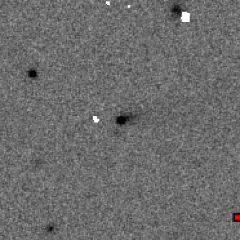
In this project first, after volunteers flagged 2010 LH15 as showing activity, we uncovered images of the object with activity from two different orbits. The activity took place near the point in the object's orbit where is closest to the Sun. This fact, combined with its recurrent activity, indicates 2010 LH15 is a member of the rare Main-belt comet (MBC) class. The open access publication can be found here.
Citation: Chandler, C.O., Oldroyd, W.J., Hsieh, H.H., Trujillo, C.A., Burris, W.A., Kueny, J.K., DeSpain, J.A., Farrell, K.A., Mazzucato, M.T., Bosch, M.K.D., Shaw-Diaz, T., Gonano, V., 2023. New Recurrently Active Main-belt Comet 2010 LH15. Research Notes of the American Astronomical Society 7, 60. https://doi.org/10.3847/2515-5172/acc57e
New Quasi-Hilda Comet 2009 DQ118 (2023 March 7 & 2023 October)
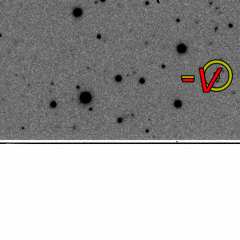
Description: In this project first, we observed this object (with the 3.5 m Apache Point Observatory ARC telescope in New Mexico and the 6.5 m Baade (Magellan) Telescope in Chile) after volunteers identified it as active, and we discovered the object to be active again during an entirely different orbit. The open access peer-reviewed publication (October 2023) is here, and the original Note (also open access) from March 2023 is here.
Citation: Oldroyd, W.J., Chandler, C.O., Trujillo, C.A., Sheppard, S.S., Hsieh, H.H., Kueny, J.K., Burris, W.A., DeSpain, J.A., Farrell, K.A., Mazzucato, M.T., Bosch, M.K.D., Shaw-Diaz, T., Gonano, V., 2023. Recurring Activity Discovered on Quasi-Hilda 2009 DQ118. ApJL 957, L1. https://doi.org/10.3847/2041-8213/acfcbc
New Active Asteroid 2015 VA108 (2023 February 20)
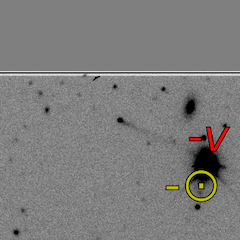
Our second active asteroid discovery was flagged by project volunteers, and our team found additional images during our archival investigation. The open-access publication can be found here.
Citation: Chandler, C.O., Oldroyd, W.J., Trujillo, C.A., Burris, W.A., Hsieh, H.H., Kueny, J.K., Mazzucato, M.T., Bosch, M.K.D., Shaw-Diaz, T., 2023. New Active Asteroid 2015 VA108: A Citizen Science Discovery. Research Notes of the American Astronomical Society 7, 27. https://doi.org/10.3847/2515-5172/acbbce
New Active Asteroid 2015 FW412 (2023 February 14)
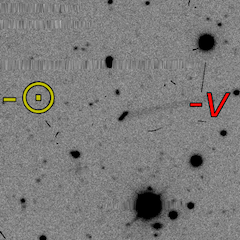
Discovery of activity emanating from 2015 FW412 represents the first unambiguous active asteroid discovery stemming directly from Active Asteroids volunteer efforts. The object is a candidate main-belt comet (MBC), a rare class of active asteroid that orbits entirely within the asteroid belt and displays activity attributed to volatile sublimation. The open-access publication can be found here.
Citation: Chandler, C.O., Trujillo, C.A., Oldroyd, W.J., Kueny, J.K., Burris, W.A., Hsieh, H.H., Mazzucato, M.T., Bosch, M.K.D., Shaw-Diaz, T., 2023. Discovery of Dust Emission Activity Emanating from Main-belt Asteroid 2015 FW412. Research Notes of the American Astronomical Society 7, 22. https://doi.org/10.3847/2515-5172/acbb69
Three New Active Objects and Active Asteroids Project Methods (2022 September 28)
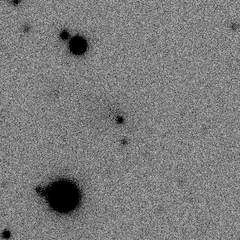
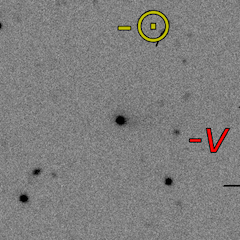
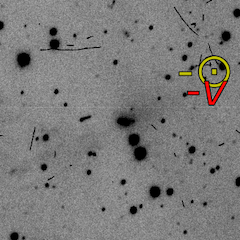
Project founder Colin Orion Chandler published his dissertation "" roughly one year following Active Asteroids project launch. In the comprehensive methods the Active Asteroids project is described in detail. Three active objects, all classified by project volunteers as well as members of our team, were included: 2000 AU242, 2015 TC1, and 2017 QN84. The full dissertation is freely available here.
Citation: Chandler, C. O. (2022). "Chasing Tails: Active Asteroid, Centaur, and Quasi-Hilda Discovery with Astroinformatics and Citizen Science." Doctoral dissertation, Northern Arizona University, ProQuest.
Surprise Findings via Citizen Science: an Active Quasi-Hilda (2022 September 14)
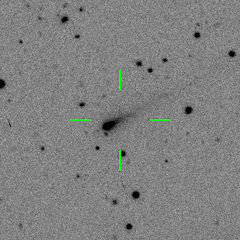
Volunteers from Active Asteroids identified images of comet 282P, also known as asteroid (323137) 2003 BM80, as showing activity. While the object was actually already known to be active, two important findings stemmed directly from the project findings: (1) 282P is recurrently active, suggesting probable volatile sublimation, and (2) our dynamical modeling revealed the object is actually a quasi-Hilda object, a class of minor planet that has an unusual orbit strongly connected with Jupiter's gravitational influence. The full article is freely available here.
Citation: Chandler, Colin Orion, William J. Oldroyd, and Chadwick A. Trujillo. "Migratory Outbursting Quasi-Hilda Object 282P/(323137) 2003 BM80." The Astrophysical Journal Letters 937, no. 1 (2022): L2.
Discovery of Additional Activity Epoch for New Active Asteroid (2021 November 17)
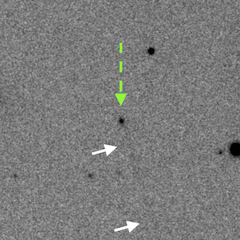
As with the (6478) Gault case in 2019, our team set out to find additional images of asteroid (248370) 2005 QN173, which had recently been discovered to be active. Making use of the system we designed for Active Asteroids we found an image that unambiguously showed the object had been active during a prior orbit. In both cases activity occurred near perihelion (the object's close approach to the Sun), typically indicative of volatile sublimation. Thus we identified (248370) 2005 QN173 as a likely Main-Belt Comet, a rare subset of active asteroid that orbits within the main astroid belt (found between the orbits of Mars and Jupiter). The full article can be found here.
Citation: Chandler, Colin Orion, Chadwick A. Trujillo, and Henry H. Hsieh. "Recurrent activity from active asteroid (248370) 2005 QN173: a main-belt comet." The Astrophysical Journal Letters 922, no. 1 (2021): L8.
Active Centaur Discovery
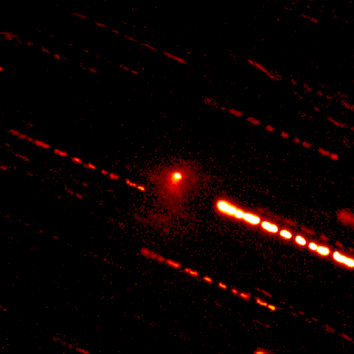
As part of testing in preparation for the project, the team routinely examines batches of images to simulate the classification process that the Citizen Scientists will be asked to perform. During one of these sessions, cofounders Colin, Jay, and Chad each noticed an unusual "smudge" kept showing up around one particular object. The object was a Centaur, an icy body with an orbit between Jupiter and Neptune. They carried out follow-up observations with other telescopes -- again simulating the workflow designed for the Citizen Science project -- and discovered the object was active! This object -- known as 2014 OG392 -- is one of only about 20 active Centaurs discovered since 1929. The image above shows the object during our follow-up campaign. The team published their findings as "Cometary Activity Discovered on a Distant Centaur: A Nonaqueous Sublimation Mechanism" in the Astrophysical Journal Letters. The Gold Open Access (free) article is available here.
Citation: Chandler, Colin Orion, Jay K. Kueny, Chadwick A. Trujillo, David E. Trilling, and William J. Oldroyd. "Cometary Activity Discovered on a Distant Centaur: A Nonaqueous Sublimation Mechanism." The Astrophysical Journal Letters 892, no. 2 (2020): L38.
Confirming Historical Activity (2019 May 1)

While preparing for this project the team investigated a newly found active asteroid -- known as (6478) Gault -- and made two key discoveries. First, the team found (6478) Gault had a comet-like tail (white arrows in the image above) since at least 2013. Second, because the tail is thought to be caused by Gault spinning so fast that it is breaking apart, the object was displaying the longest duration of activity produced by this phenomenon ever seen -- a new class of active asteroid! The team published their findings in the article "Six Years of Sustained Activity in (6478) Gault" published in the Astrophysical Journal Letters. The Gold Open Access (free) article is available here.
Citation: Chandler, Colin Orion, Jay Kueny, Annika Gustafsson, Chadwick A. Trujillo, Tyler D. Robinson, and David E. Trilling. "Six Years of Sustained Activity in (6478) Gault." The Astrophysical Journal Letters 877, no. 1 (2019): L12.
Proof-Of-Concept (2018 November 11)

Prior to proposing this project idea to the National Science Foundation Graduate Research Fellowship Program (NSF GRFP) a team of scientists -- led by project founder Colin Orion Chandler -- designed and carried out a project as a "proof-of-concept" to demonstrate that the Dark Energy Camera (DECam) dataset was suitable to identifying active asteroids, including the active asteroid called "(62412)" shown in the image above. The project was a resounding success, and the findings were published in the peer-reviewed journal article "SAFARI: Searching Asteroids for Activity Revealing Indicators" published in Publication of the Astronomical Society of the Pacific. The article can be found here.
Citation: Chandler, Colin Orion, Anthony M. Curtis, Michael Mommert, Scott S. Sheppard, and Chadwick A. Trujillo. "SAFARI: Searching asteroids for activity revealing indicators." Publications of the Astronomical Society of the Pacific 130, no. 993 (2018): 114502.